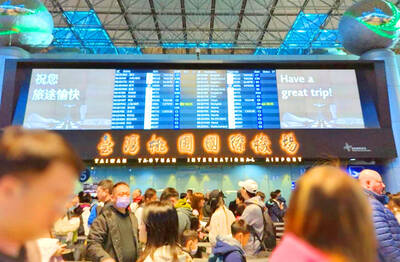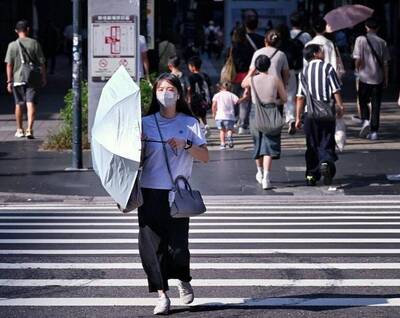The Cabinet yesterday approved a four-year science and technology development program to boost the digital economy and to use “smart” technologies to meet various challenges facing the nation, such as an aging population and climate change.
The National Science and Technology Development Plan outlines four major categories of development from this year to 2020 to help the nation adapt to changing industrial trends: innovating and recreating economic momentum with digital technologies; developing “smart” assistive living technologies and industries; cultivating and attracting talent; and building a thriving research and innovation ecosystem.
To achieve those goals, the Ministry of Science and Technology is to build an “Artificial Intelligence (AI) Robot Maker Space” over a four-year period with a NT$2 billion (US$65.8 million) budget, which is to become a center for innovative economics, ministry officials told a news conference in Taipei.
Digital technologies are to be used to meet the challenges of an aging population, a low fertility rate, outbreaks of contagious disease, extreme weather and food safety issues, Deputy Minister of Science and Technology Su Fong-chin (蘇芳慶) said.
Renewable energy and disaster prevention would also be a major focus of the program, including a smart power grid project to boost the share of renewable energy production to 20 percent by 2025 and the development of a disaster prevention system.
The program is also to allocate funds to retain international talent and offer scholarships for young researchers to study in California’s Silicon Valley.
It includes the proposed “Yushan Scholar” project, which would offer a subsidy of up to NT$5 million per year to selected academics and researchers on top of their annual salary.
The ministry plans to amend the Fundamental Science and Technology Act (科學技術基本法) and other relevant laws to allow academics and researchers to work on extracurricular projects and receive dividends from their patents to boost innovation.
“Technological advantage is key to a nation’s competitiveness, and Taiwan has to utilize its technological edge to speed up scientific and technological development,” Premier William Lai (賴清德) said.
The “five plus two” industrial development project — an initiative to develop an “Asian Silicon Valley,” biomedicine, “green” energy, “smart” machinery and a national defense industry, as well as a new agricultural model and a circular economy — is based on the nation’s advanced semiconductor and information and communication technology industries, Lai said.
The relationship between the “five plus two” project and those industries is reciprocal and the government will not ignore those industries, Lai added, after Taiwan Semiconductor Manufacturing Co chairman Morris Chang (張忠謀) complained about the focus on developing the “five plus two” industries.

Three Taiwanese airlines have prohibited passengers from packing Bluetooth earbuds and their charger cases in checked luggage. EVA Air and Uni Air said that Bluetooth earbuds and charger cases are categorized as portable electronic devices, which should be switched off if they are placed in checked luggage based on international aviation safety regulations. They must not be in standby or sleep mode. However, as charging would continue when earbuds are placed in the charger cases, which would contravene international aviation regulations, their cases must be carried as hand luggage, they said. Tigerair Taiwan said that earbud charger cases are equipped

Foreign travelers entering Taiwan on a short layover via Taiwan Taoyuan International Airport are receiving NT$600 gift vouchers from yesterday, the Tourism Administration said, adding that it hopes the incentive would boost tourism consumption at the airport. The program, which allows travelers holding non-Taiwan passports who enter the country during a layover of up to 24 hours to claim a voucher, aims to promote attractions at the airport, the agency said in a statement on Friday. To participate, travelers must sign up on the campaign Web site, the agency said. They can then present their passport and boarding pass for their connecting international

Temperatures in northern Taiwan are forecast to reach as high as 30°C today, as an ongoing northeasterly seasonal wind system weakens, the Central Weather Administration (CWA) said. CWA forecaster Tseng Chao-cheng (曾昭誠) said yesterday that with the seasonal wind system weakening, warmer easterly winds would boost the temperature today. Daytime temperatures in northern Taiwan and Yilan County are expected to range from 28°C to 30°C today, up about 3°C from yesterday, Tseng said. According to the CWA, temperature highs in central and southern Taiwan could stay stable. However, the weather is expected to turn cooler starting tonight as the northeasterly wind system strengthens again

Taiwan sweltered through its hottest October on record, the Central Weather Administration (CWA) said yesterday, the latest in a string of global temperature records. The main island endured its highest average temperature since 1950, CWA forecaster Liu Pei-teng said. Temperatures the world over have soared in recent years as human-induced climate change contributes to ever more erratic weather patterns. Taiwan’s average temperature was 27.381°C as of Thursday, Liu said. Liu said the average could slip 0.1°C by the end of yesterday, but it would still be higher than the previous record of 27.009°C in 2016. "The temperature only started lowering around Oct. 18 or 19